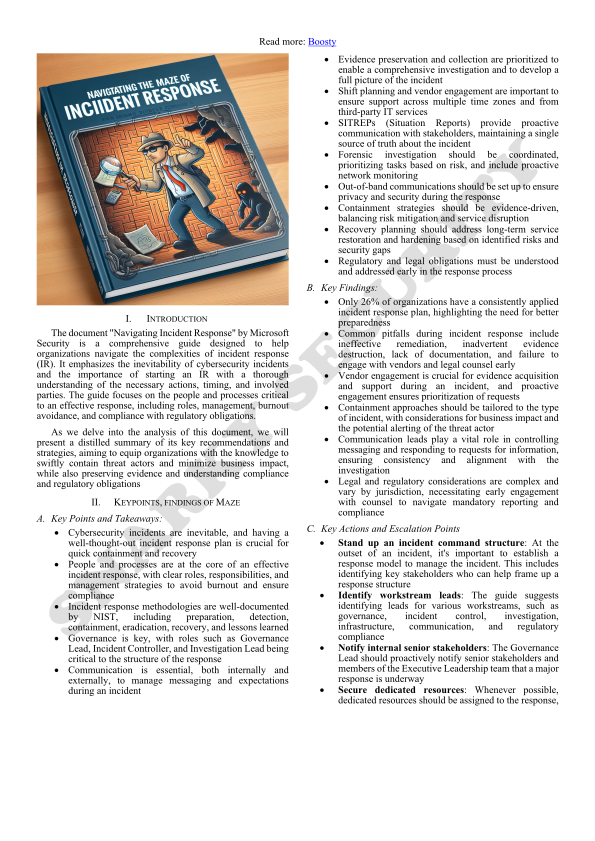HABs and Cyberbiosecurity. Because Your Digital Algal Blooms Needs a Firewall. Announcement

This document provides a comprehensive analysis of the multifaceted harmful impacts, with a focus on the integration of cyberbiosecurity measures. The analysis encompasses several critical aspects: the ecological and health impacts, the technological advancements in monitoring and detection, and the emerging field of cyberbiosecurity. Because clearly, we all lose sleep over these thrilling topics.
The document introduces the concept of cyberbiosecurity, a critical aspect given the reliance on sophisticated technologies for monitoring biosecurity issues. Oh joy, another buzzword to set our hearts racing. It discusses potential cyber threats, such as data injection attacks and automated system hijacking, which could undermine water security efforts.
In all seriousness, while the subject matter may seem dry, the potential consequences of not addressing cyberbiosecurity threats could be catastrophic for public health and environmental safety. This document provides a sobering analysis that demands our full attention and diligence.
This document provides a detailed analysis of the multifaceted harfmul impacts, with a focus on the integration of cyberbiosecurity measures. The analysis encompasses several critical aspects: the ecological and health impacts, the technological advancements in monitoring and detection, and the emerging field of cyberbiosecurity. The document discusses potential cyber threats, such as data injection attacks and automated system hijacking, which could undermine water security efforts. The analysis underscores the need for robust cybersecurity measures to protect the integrity of water monitoring systems.
This comprehensive analysis is beneficial for security professionals, environmental scientists, and policymakers. The insights gained from this analysis are crucial for developing strategies to protect public health and ensure the safety of freshwater resources in various industries and sectors
Cyberbiosecurity is an emerging interdisciplinary field that addresses the convergence of cybersecurity, biosecurity, and cyber-physical security and other unique challenges. Its development is driven by the need to protect increasingly interconnected and digitized biological systems and data from emerging cyber threats. It focuses on protecting the integrity, confidentiality, and availability of critical biological and biomedical data, systems, and infrastructure from cyber threats. This discipline is relevant in contexts where biological and digital systems interact, such as in biopharmaceutical manufacturing, biotechnology research, and healthcare.
Scope
Cyberbiosecurity is defined as understanding the vulnerabilities to unwanted surveillance, intrusions, and malicious activities that can occur within or at the interfaces of combined life sciences, cyber, cyber-physical, supply chain, and infrastructure systems. It involves developing and instituting measures to prevent, protect against, mitigate, investigate, and attribute such threats, with a focus on ensuring security, competitiveness, and resilience.
Key Aspects of Cyberbiosecurity
📌 Integration of Disciplines: Cyberbiosecurity merges principles from cybersecurity (protection of digital systems), biosecurity (protection against misuse of biological materials), and cyber-physical security (security of systems that bridge the digital and physical worlds). This integration is crucial due to the increasing digitization and interconnectivity of biological data and systems.
📌 Protection Across Various Sectors: The field spans multiple sectors including healthcare, agriculture, environmental management, and biomanufacturing. It addresses risks associated with the use of digital technologies in these areas, such as the potential for hacking of biotechnological devices or unauthorized access to genetic data.
📌 Emerging Threat Landscape: As biotechnological and digital advancements continue, the threat landscape evolves, presenting new challenges that cyberbiosecurity aims to address. These include protecting against the theft or corruption of critical research data, securing networked medical devices, and safeguarding automated biomanufacturing processes from cyberattacks.
📌 Regulatory and Policy Development: Given the novelty and complexity of the challenges in cyberbiosecurity, there is a significant need for developing appropriate governance, policy, and regulatory frameworks.
📌 Education and Awareness: Building capacity through education and training is essential to advance cyberbiosecurity. Stakeholders across various disciplines need to be aware of the potential cyberbiosecurity risks and equipped with the knowledge to mitigate these risks effectively.
BIOLOGICAL HARMFUL THREATS
📌 Data Integrity and Confidentiality Breaches: Biological data, such as genetic information and health records, are increasingly digitized and stored in cyber systems. Unauthorized access or manipulation of this data can lead to significant privacy violations and potentially harmful misuses.
📌 Contamination and Sabotage of Biological Systems: Cyber-physical attacks can lead to the direct contamination of biological systems. For example, hackers could potentially alter the controls of biotechnological equipment, leading to the unintended production of harmful substances or the sabotage of critical biological research.
📌 Disruption of Healthcare Services: Cyber-physical systems are integral to modern healthcare, from diagnostic to therapeutic devices. Cyberattacks on these systems can disrupt medical services, leading to delayed treatments or misdiagnoses, and potentially endanger patient lives.
📌 Threats to Agricultural Systems: In agriculture, cyberbiosecurity threats include the potential for cyberattacks that disrupt critical infrastructure used in the production and processing of agricultural products. This can lead to crop failures, livestock losses, and disruptions in the food supply chain.
📌 Environmental Monitoring and Management: Cyberbiosecurity also encompasses threats to systems that monitor and manage environmental health, such as water quality sensors and air quality monitoring stations. Compromising these systems can lead to incorrect data that may prevent the timely detection of environmental hazards, such as toxic algal blooms or chemical spills.
📌 Spread of Misinformation: The manipulation of biological data and the dissemination of false information can lead to public health scares, misinformation regarding disease outbreaks, or mistrust in public health systems. This type of cyber threat can have widespread social and economic impacts.
📌 Biotechnology and Synthetic Biology: As biotechnological and synthetic biology capabilities advance, the potential for their misuse increases if cyberbiosecurity measures are not adequately enforced. This includes the creation of harmful biological agents or materials that could be used in bioterrorism.
📌 Regulatory and Compliance Risks: Organizations that handle sensitive biological data must comply with numerous regulatory requirements. Cyberattacks that lead to non-compliance can result in legal penalties, loss of licenses, and significant financial damages.
📌 Insider Threats: Insiders with access to both cyber and biological systems pose a significant threat as they can manipulate or steal sensitive information or biological materials without needing to breach external security measures.
📌 Data Injection Attacks: These involve the insertion of incorrect or malicious data into a system, which can lead to erroneous outputs or decisions. In the context of HAB monitoring, for example, data injection could mislead response efforts or corrupt research data.
📌 Automated System Hijacking: This threat involves unauthorized control of automated systems, potentially leading to misuse or sabotage. For instance, automated systems used in water treatment or monitoring could be hijacked to disrupt operations or cause environmental damage.
📌 Node Forgery Attacks: In systems that rely on multiple sensors or nodes, forging a node can allow an attacker to inject false data or take over the network. This can compromise the integrity of the data collected and the decisions made based on this data.
📌 Attacks on Learning Algorithms: Machine learning algorithms are increasingly used to analyze complex biological data. These algorithms can be targeted by attacks designed to manipulate their learning process or output, leading to flawed models or incorrect analyses.
📌 Cyber-Physical System Vulnerabilities: The integration of cyber systems with physical processes (CPS) introduces vulnerabilities where physical damage can result from cyber-attacks. This includes threats to infrastructure that supports biological research and public health, such as power grids or water systems
📌 Intellectual Property Theft: In sectors like biotechnology, where research and development are key, cyberbiosecurity threats include the theft of intellectual property. This can occur through cyber-attacks aimed at accessing confidential data on new technologies or biological discoveries
📌 Bioeconomic Espionage: Like intellectual property theft, bioeconomic espionage involves the unauthorized access to confidential economic data related to biological resources. This could impact national security, especially if such data pertains to critical agricultural or environmental technologies.
📌 Contamination of Biological Data: The integrity of biological data is crucial for research and application in fields like genomics and epidemiology. Cyber-attacks that alter or corrupt this data can have serious consequences for public health, clinical research, and biological sciences.
📌 Supply Chain Vulnerabilities: The bioeconomy relies on complex supply chains that can be disrupted by cyber-attacks. This includes the supply chains for pharmaceuticals, agricultural products, and other biological materials
📌 AI-Driven Bioweapon Creation: The misuse of AI in the context of cyberbiosecurity could lead to the development of biological weapons, to design pathogens or to optimize the conditions for their growth, posing a significant bioterrorism threat















